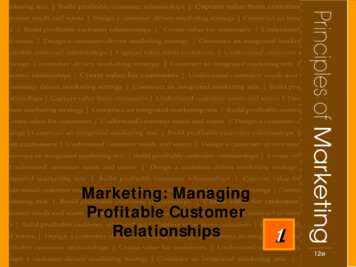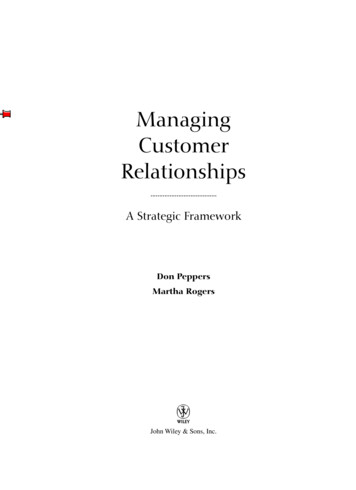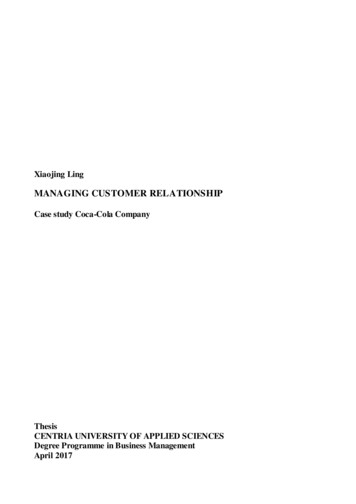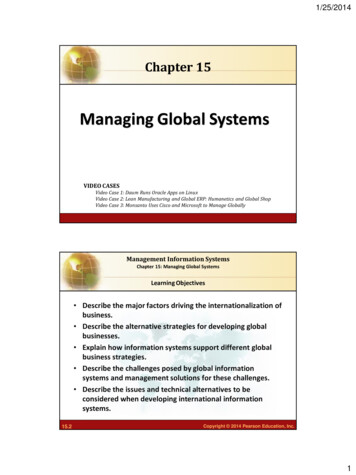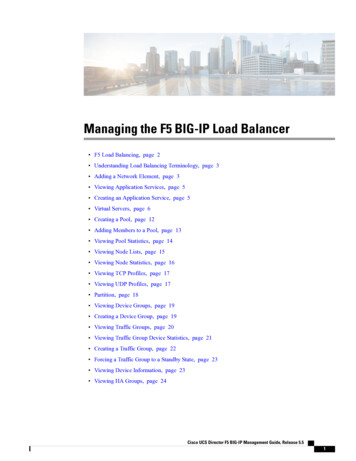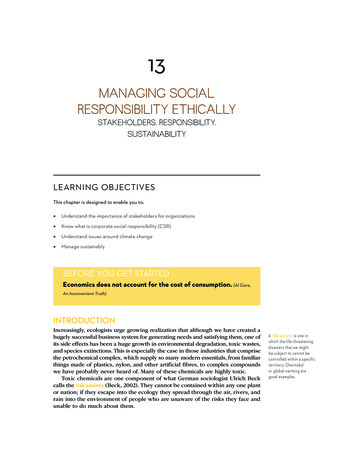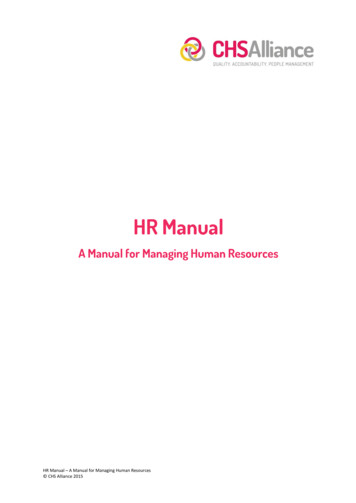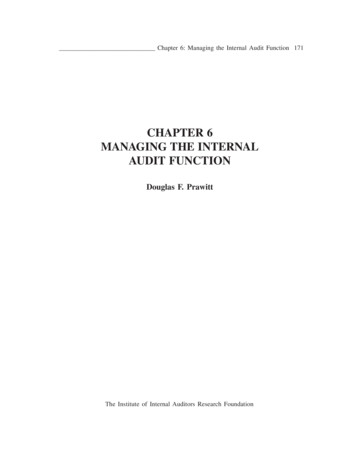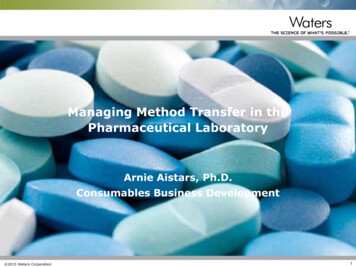
Transcription
Managing Method Transfer in thePharmaceutical LaboratoryArnie Aistars, Ph.D.Consumables Business Development 2015 Waters Corporation1
Agenda USP 621 Chromatography Change Update– Taking advantage of the change– Examples Strategy for Successful Method Transfer– Prevention– Troubleshooting– Sources of Contamination Method Transfer Principle Summary 2015 Waters Corporation2
USP 621 ChromatographyDefines “Allowable Adjustments” Adjustments to a USP method may be made to meet system suitabilityrequirements Verification tests must be performed after changes– Full re-validation not required Must use the same L-designation of column Isocratic hold or dwell volume adjustments are allowedUSP 37 NF 32 S1- Official Aug. 1, 2014- Significant changes to Chapter 621 Chromatography 2015 Waters Corporation3
USP 37-NF 32 through FirstSupplement - August 1, 2014VariableUSP 36-NF 31Particle Size-50%Column Length 70%Flow RateF2 F1 (d22/d12) and 50%USP 37-NF 32Through first supplementIsocraticGradientL/dp Ratio Constantor N: -25 to 50%No changesallowedNo changesallowedF2 F1 x[(dc22 x dp1)/dc12 xdp2)] and 50%Not applicableColumn IDAny allowed if linear velocity Any allowed if linear velocity isis constantconstantNo changesallowedInjection VolumeAny reduction consistent with Can be adjusted as consistentprecision and detection limits; with precision and detectionno increase permittedlimitsCan be adjusted asconsistent withprecision anddetection limitsColumn Temperature 10% 10% 10%Mobile Phase pH 0.2 unit 0.2 unit 0.2 unitF Flow rate; d internal column diameter; dc column diameter, dp particle size 2015 Waters Corporation4
Scaling Existing Separations 2015 Waters Corporation5
Taking Advantage of ‘AllowableAdjustments’ in USP 621 Isocratic Methods- Improve analysis speed and quality with UPLC andsub-2-µm columns- Improve methods with CORTECS 2.7 µm or 2.5 µmXP columns on HPLC systems- No re-validation requiredGradient Methods- Any change requires re-validation- Fully optimize methods using sub-2-µm particlesand UPLC- Develop better methods faster with ACQUITY QDamass detectorSystem- Future-proof the lab: Both HPLC and UPLC methodscan be run on the ACQUITY UPLC H-Class systemSoftware- ACQUITY Columns Calculator for proper transfers- Streamline verification and validation testing withEmpower Method Validation Manager 2015 Waters Corporation6
Agenda USP 621 Chromatography Change Update– Taking advantage of the change– Examples Strategy for Successful Method Transfer– Prevention– Troubleshooting– Sources of Contamination Method Transfer Principle Summary 2015 Waters Corporation7
USP Compendial Methods:Potential Issues Mobile phase– High buffer salt concentration in mobile phase– High concentrations of modifiers (phosphoric acid, TEA etc.)– pH may be close to the limits of traditional column packingmaterials Method– Not always an optimized method Sample–––––Complex formulations: tablets, suspensions, ointmentsMinimal, inadequate sample preparationNew excipients may not be compatible with USP methodSample may not be fully soluble in diluent/mobile phaseMethods (often isocratic) may not elute all sample components API, related substances, formulation excipients 2015 Waters Corporation8
Strategy for SuccessfulMethod Transfer to UPLCDetermine Method CompatibilityPreventionPrepare UPLC System & Mobile PhaseMethod Transfer and Routine AnalysisSuccessfulTransfer 2015 Waters Corporation9
Determining UPLC MethodCompatibility Did the separation ever work well on an HPLC system?– Check buffer salt solubility with bench top experiment Does the HPLC method properly elute ALL excipients as well asthe API and related substances?– Look at the properties of formulation components and theircompatibility with the original USP method Solubility in diluent and mobile phase Stability (temperature, pH)– Modifications to sample preparation or method MAY be required, toprevent sample build-up on column 2015 Waters Corporation10
System Preparation and Mobile Phase System– Ensure the system has been cleaned regularly– Sonicate or replace solvent filters to ensure cleanlinessoSinkers are significant source of bacteria– Run a system performance standard to ensure system is in properworking condition Mobile Phase– Prepare fresh mobile phase– Use high quality, branded mobile phase solvents– Use high purity mobile phase buffers and reagents– Consider filtering or purchasing pre-filtered mobile phase solvents– Ensure that the mobile phase pH is compatible with the column 2015 Waters Corporation11
Strategy for SuccessfulMethod TransferDetermine Method CompatibilityPreventionPrepare UPLC System & Mobile PhasesMethod Transfer and Routine AnalysisFailureSuccessTroubleshootingSystem 2015 Waters CorporationSample12
Quick TroubleshootingFailingchromatography- Poor peak shape- Tailing- RT shifts- Drop in plate count- System overpressureDoes a freshsample help?YESSample Stability-check sample stabilityNODoes columnwashing help?YESInsufficient Wash-build a column washing stepinto each sample set or runNOParticulates/BacteriaDoes replacingcolumn inlet/outletfrits help? (fortroubleshooting only)NOYES-clean system-replace sinkers-make fresh mobile phase-filter mobile phase-use pre-column filter-re-examine sample matrixsolubility and sample prepColumn BedContamination 2015 Waters Corporation13
Bacterial Contamination Bacteria in the system is a common cause of column failure Microbial build-up occurs in all systems running aqueous mobilephase Does not only occur at neutral pH 15 minutes is all it takes when conditions are rightSEM: column inlet frit, inlet side 2015 Waters Corporation14
Effect of Bacterial Contaminationon ChromatographyProtein Mix0.14Time 1 h0.12Injection 6270.10AU0.080.060.020.000.00Column contaminated withbacteria (confirmed by SEManalysis of column frit)Time 2.17 dInjection .00Conditions: 25mM sodium phosphate, 150 mM sodium chloride, pH6.8, 0.4 mL/min, Injection vol: 4 µL, Wavelength: 280 nm 2015 Waters Corporation15
PreventingBacterial Contamination Tips– Replace sinkers (high source of bacteria)– Prepare mobile phase fresh daily– Pre-mix isocratic mobile phase with organic solvents– Add starting % organic to aqueous mobile phases and adjust thegradient accordingly– Flush the system regularly (with column removed) using a series ofwater/acid/organic washes to eliminate microbial growth.oSee “Controlling Contamination in UltraPerformance LC /MSand HPLC/MS Systems” PN 715001307– Do NOT perform a hot water wash: this will worsen contamination 2015 Waters Corporation16
Column Bed Contamination:Is it from the System or Sample?Failingchromatography- Poor peak shape- Tailing- RT shifts- Drop in plate count- System overpressureNot related tosample stability,washing orparticulatesIs a routine usestudy with diluentblanks on a NEWcolumn succesful?(standard every 20injections)NOSystemissue 2015 Waters CorporationColumn BedContamination-Clean systemPM systemFresh mobile phaseNew sinkersFurther investigate systemcontamination- Bacteria (less than 0.2 µm)- Mobile phase impurities- Filter compatibility- Column stability undermethod pH and temperatureconditions17
Preventing System-relatedColumn Bed Contamination Tips– Prevent bacterial growth in system– Use high quality, high purity reagents for mobile phase– Consider using a VanGuard pre-column– Ensure that the column being used is stable at the pH andtemperature specified in the method– Check chemical compatibility of filters (sample/mobile phase) withthe solvents being usedPolysulphone material from filtermembranes plugging inlet frit 2015 Waters Corporation18
Agenda USP 621 Chromatography Change Update– Taking advantage of the change– Examples Strategy for Successful Method Transfer– Prevention– Troubleshooting– Sources of Contamination Method Transfer Principle Summary 2015 Waters Corporation19
Method Transfer ScenariosHPLC MethodTransferred toUPLC PlatformScaled toUPLC MethodScaled toHPLC Method 2015 Waters Corporation20
Differences in System Volume:Low vs. High Pressure MixingMultiple/Dual Pumps (Binary) – High Pressure MixingSmaller System Volume Smaller Dwell volumeSolvent mixing:After going through the pumpPump AOr pre-mixed solvents onlyMixerInjectorColumnDetectorSmaller system volumePump BMinimal dispersionSingle Pump (Quaternary) - Low Pressure MixingLarger System Volume Larger Dwell volumeSolvent mixing:Before going through the pumpABDCPumpGradientProportioningValve 2015 Waters CorporationInjectorColumnDetectorLarger system volumeAuto·Blend :For mobile phase generation21
System VolumeTiming OffsetActual mobile phaseprofile on originalsystem measured atthe column inletSolvent Compositionat MixerSolvent Composition {at Column Head}0InjectiontgxTimeSystem volume creates an offset before the solventcomposition change reaches the inlet of column(i.e., an “isocratic hold” at the beginning of every gradient) 2015 Waters Corporation22
Different System VolumesEffect on SeparationOriginal InstrumentSystem Volume 0.9 mLSmaller VolumeSystem Volume 0.35 mLTarget System with smaller volume(less isocratic hold time) 2015 Waters CorporationLarger VolumeSystem Volume 1.4 mLTarget System with larger volume(longer isocratic hold time)23
Gradient Type:Compensating for System Volumes Compare system volumes– This volume should be converted to “column volumes (CVs)” forthe best comparison If target system gives smallerisocratic segment— ADD an initial hold to thegradient table to give theidentical hold 2015 Waters Corporation If target system gives largerisocratic segment— Use the pre-injector volumefeature24
Scaling Injection VolumeGuideline:Injection volume should be less than 5% of column volume.Aim for 1% and experimentally determine if you can go higherbased on chromatographic conditions.4.6 x 150 mm2.49 mL20 µL injection/2.49 mL 0.8%2.1 x 50 mm0.17 mL20 µL injection/0.17 mL 12%If you inject too much, the result will be poor peak shapedue to volume overload 2015 Waters Corporation25
ACQUITY UPLC Columns CalculatorACQUITY UPLC Columns Calculator handles these calculations 2015 Waters Corporation26
Three Method Transfer Scenarios Scenario 1 : Maximizing Asset Utilization– Applying existing HPLC methods onto HPLC and ACQUITYUPLC H-Class systems– Adapting HPLC methods to different system designs Scenario 2 : Transferring a HPLC method to UPLCsystems– Converting a legacy HPLC method into a UPLC method Scenario 3: Transferring a UPLC method to HPLCsystems– Taking advantage of UPLC for quickly and efficientlydeveloping a method– Transfer this method to labs still equipped with HPLCsystems 2015 Waters Corporation27
Scenario 1 - Maximizing Asset Utilization: AdaptingHPLC Methods to Different Systems DesignFuture-proofing your labInvest in new instrumentation that can run both legacy HPLCmethods and UPLC methods for new projectsGoalTransfer existing HPLC method to a different LC systemMust compensate for system dwell volume differences 2015 Waters Corporation28
Scenario 1:LC Instrument TransferOriginal InstrumentSystem Volume 0.9 mLColumn Volume 4.6 x100 mm : 1.66 mlConversion in column volumes :0.9/1.66 0.54 cvTarget System with smaller volume (less isocratic hold time)Must compensate with an isocratic hold to preserve separationSmaller VolumeSystem Volume 0.35 mLColumn Volume 4.6 x100 mm : 1.66 mlConversion in column volumes :0.35/1.66 0.21 cv 2015 Waters Corporation29
Scenario 1:HPLC to HPLC Method TransferDwell VolumeTo preserve the gradientprofile when transferringfrom one instrument toanother, the systemdwell volume must beconsidered. 2015 Waters Corporation30
Scenario 1:HPLC to HPLC Method TransferGradient ColumnVolumesTo preserve the gradientprofile, the number ofgradient column volumes foreach step, should bemaintained.As a result, the gradienttime table has beenadjusted. 2015 Waters Corporation31
Why Add an Isocratic Hold?InjectionAlliance HPLCSystem with larger dwell volume(longer isocratic hold time)InjectionACQUITYUPLC H-Class 2015 Waters Corporation1. Isocratic Hold2. TubingSystem with smaller dwell volume(less isocratic hold time)32
Scenario 1 - The Result:HPLC to HPLC Method TransferRelative RT to ClozapinePeakH-ClassHPLCImpurity D0.8670.865Impurity C0.8980.895Impurity A0.9510.950Clozapine1.0001.000Impurity B1.5071.513Future-proof your labRun HPLC methods onACQUITY UPLC H-ClassFlexibility to run bothHPLC and UPLC methods 2015 Waters Corporation33
Ease of Method Transfer Between LCPlatformsHPLCXSelect HSS T3Flow rate 1.9 mL/minPc lycitin4.6 x 50 mm, 2.5 µm XPa QUITY UPLC H-Class7.008.009.00XSelect HSS T3Transfer methodsbetweendifferent LC systems4.6 x 50 mm, 2.5 µm XPFlow rate 1.9 mL/minPc 94a (Daidzin)1.630.001.00 2015 Waters 34
Three Method Transfer Scenarios Scenario 1 : Maximizing Asset Utilization– Applying existing HPLC methods onto HPLC and ACQUITYUPLC H-Class systems– Adapting HPLC methods to different system designs Scenario 2 : Transferring a HPLC method to UPLCsystems– Converting a legacy HPLC method into a UPLC method Scenario 3: Transferring a UPLC method to HPLCsystems– Taking advantage of UPLC for quickly and efficientlydeveloping a method– Transfer this method to labs still equipped with HPLCsystems 2015 Waters Corporation35
Scenario 2: Turning a Legacy HPLCMethod Into a UPLC MethodHPLC Separation on Alliance HPLC SystemGalantamineXBridgeTM C184.6 x 100 mm, 3.5 µm10.005.004210.00Tailing 1.60Rs Method Transfer - Reduce Analysis TimeTake advantage of sub-2-µm particle technology and transfer toACQUITY UPLC H-Class systemCriteriaUSP T
Target System with smaller volume (less isocratic hold time) Must compensate with an isocratic hold to preserve separation Column Volume 4.6 x100 mm : 1.66 ml Conversion in column volumes : 0.9/1.66 0.54 cv Column Volume 4.6 x100 mm : 1.66 ml Conversion in column volumes : 0.35/1.66 0.21 cvFile Size: 2MBPage Count: 48People also search forhplc method converterhplc method development fdahplc method transfer calculatorhplc method development ppthplc method developmenthplc method development pdf

